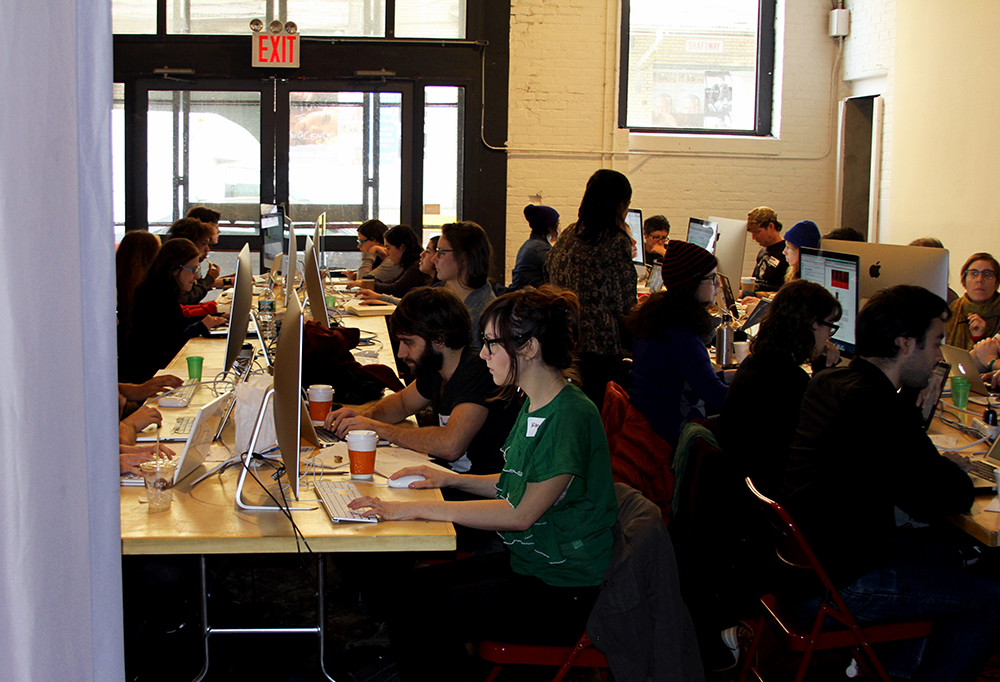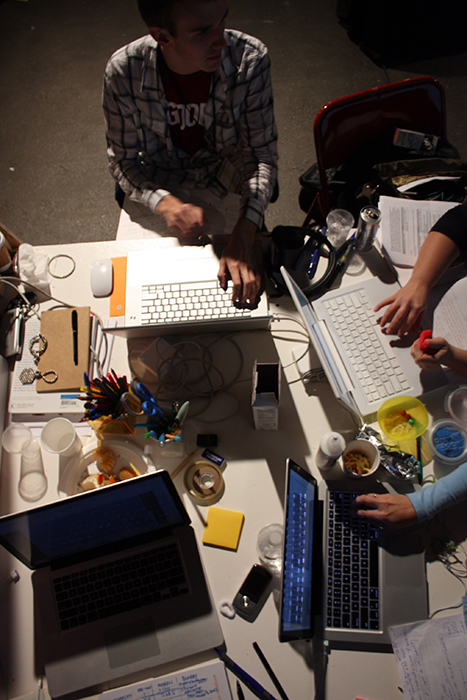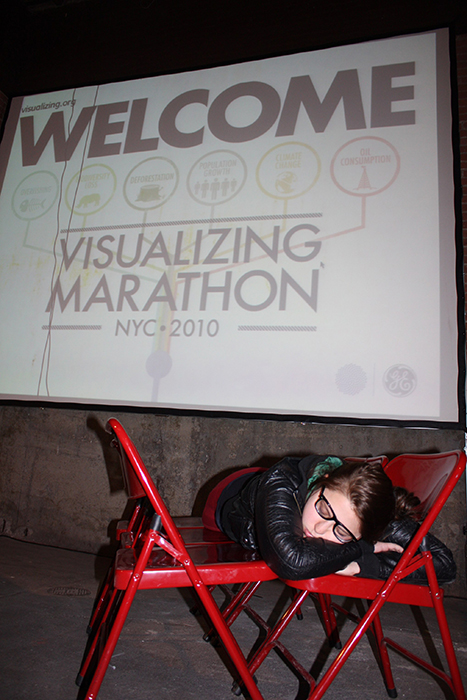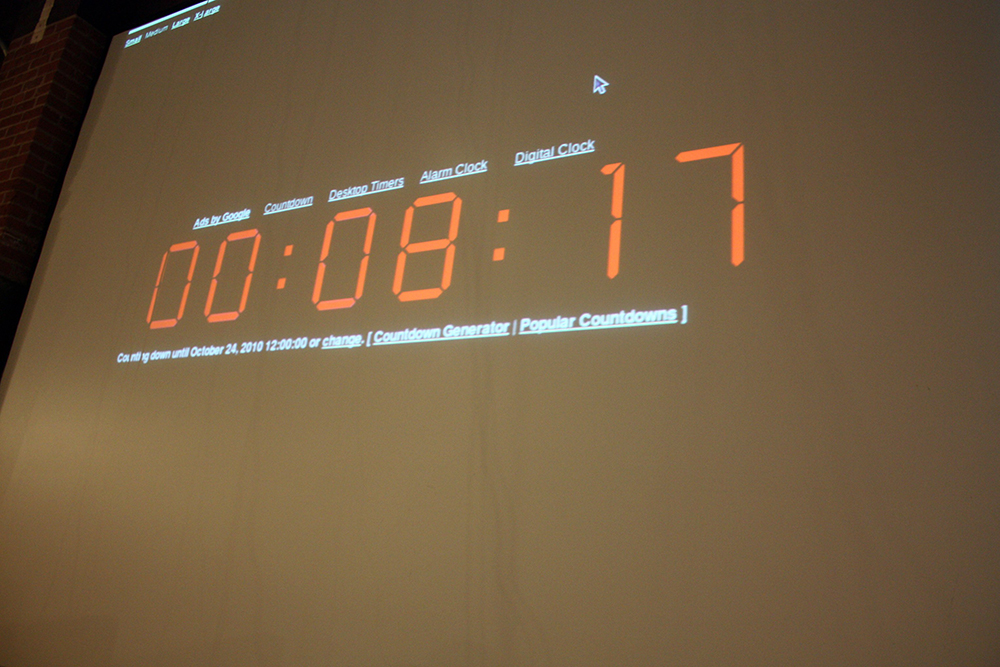“Learning to trust artists is the hardest hurdle for some institutions. Of course that is easy to say, but to really believe it enough to give support and validation to people working outside of generally understood realms, is difficult for people to accept.”—Roddy Schrock
Roddy Schrock: Director of Residencies, Eyebeam / Brooklyn NY
eyebeam.org
“learning to trust artists is the hardest hurdle for some institutions. of course that is easy to say, but to really believe it enough to give support and validation to people working outside of generally understood realms, is difficult for people to accept.”—roddy schrock
Why is physical space important to collaboration and interdisciplinary work at Eyebeam?
It is easy to put artists into a technical environment, lock them in a room, and claim that it is an art and technology residency. What makes Eyebeam unique is that we spend so much time thinking about the kind of cohort that we are building, facilitating the group that we bring in, and developing a space that encourages conversations. Everyone works in a shared studio space. Our R&D lab and wood shop are also shared, collaborative environments with a simple booking process. The fellowships are 11 month-long commitments to Eyebeam, to support research-based practice. There are no specific outcomes expected. The residencies are shorter—5 month-long commitments—and we do expect artists to produce a project by the end.
Eyebeam Facade
courtesy of ann liu alcasabas
We have formal, weekly, 45-minute group meetings with every resident and fellow, to track progress on work and help solve roadblocks. We also have monthly shop talks, where we literally require everybody to close their computers and listen to fellow artists talk about problems that they might be facing in their work. Every one of those meetings leads to somebody realizing something about their work. We think that meeting once a week is integral and helpful to everyone’s process.
In this age, it is easy to think about collaboration as a virtual experience, such as online through Skype. But actually having people physically together in the same space, at the same time, seeing the way other people work, regularly chatting in the kitchen, and having access to the kinds of applications and tools that we provide, gives people a chance for growth that I don’t see replicated in traditional residency programs.
One really good example is James Bridle, who came to us through a joint residency program Eyebeam has with The White Building in London. James had previously been through other residencies, where he worked mostly in isolation. He hadn’t been exposed to working with a lot of other people, and he spent a lot of time writing. When James came here, he immediately started collaborating with resident Ingrid Burrington. James and Ingrid developed a performative talk, a one-on-one conversation that was presented publicly in May 2014. I saw changes in the way Ingrid was thinking about her work just based on having the collaborative opportunity with James, and vice versa. The talk was a culmination of joint thinking through similar artistic problems and issues over the course of three and a half months.
Eyebeam Workshop
courtesy of roddy shrock
There is a whole history of collaborative work that develops at Eyebeam due to the physical space and participatory ethos that is allowed to take place. We like bringing in very smart, creative, aesthetically-advanced people, and putting them in the same room.
Why are you moving from Chelsea and what will the new space be like?
We are moving at the end of June 2014 to a transitional space with 7000 ft.² in Industry City. Industry City is a huge complex with other artists and organizations. We will be there for two and a half years. Our current neighborhood in West Chelsea has become a luxury housing mall. It’s a different world than when Eyebeam started, and it’s not fitting for who we are. While at Industry City, we will offer the same level of production support—a fabrication lab, wood shop, studios, and space for educational workshops. However, we won’t have a larger exhibition space, so we will be partnering with other organizations.
After two and a half years in Industry City, we will be moving into our permanent home in Brooklyn in 2016. We are building it for our specific needs, so it will offer the same support as in our Chelsea space, but will include more workspaces, a wet lab, a more polished exhibition area, and some dedicated research and prototyping areas. It’s healthy for us to take a break from our public programming cycle and rethink our ethos. If we can keep 60% of the creative chaos that we have going in Chelsea, and add 40% maturity to it, that would make it a successful transition. It’s important that we don’t lose the sense of play and fun that the Chelsea space enables.
What is that sense of play?
Eyebeam has always been a place where people can challenge one another and do things that don’t make sense. It is a space that allows people to try ideas and fail. The crazy warehouse space that we had in Chelsea allows for that. You don’t have to worry about messing things up. You don’t have to worry about whether the space will survive whatever project that you’re doing. We are working with the architects to keep that sense of play. We want a space that still allows for experimentation, and you don’t find that a lot anymore. We’ve been around long enough that we can point to that kind of space leading to real successes. For instance, Graffiti Research Lab met here to develop the EyeWriter. We know that these kinds of projects have been quite successful and it is because of the kind of space that we offer.
Can you teach people to collaborate?
No. A lot of what happens here is due to self-selection; people who apply here, understand what we do. It depends on where a person is at in their practice. Sometimes people actually need a secluded mountain cabin to think about the work that they are doing. But at another point in their career, they need a beehive of activity where they are in constant conversation with the people around them. I don’t think there’s any way to teach that. The best thing we can do is set up a formal framework that has a light touch, and do our best to find the right mix of people at any given time. It’s unpredictable.
What is the link between interdisciplinary and collaborative work?
Those words get thrown around a lot, but for us, it’s been working since 1997, so it’s not just a trend. A lot of it has to do with creative practices that have not traditionally been supported by galleries, or even museums, until recently. Eyebeam’s approach to collective practice stems from traditional models just not functioning anymore. It’s not about trying something new, but more about traditional models not keeping up with the way that people want to work. If there was no demand for the kind of support that we offer, then we would close up shop tomorrow. But this is the way that artists want to work, and artists always lead the way. There are plenty of job opportunities for engineers, but what we offer is outside of that realm.
The history of the organization has been that we support interdisciplinary work. We’re called an “Art and Technology Center,” but we don’t see a distinction between those two realms. By repeating the fact that we don’t see a distinction between those two realms, people start believing it after a while. It’s interesting to watch the larger shifts in our global culture toward an understanding of what interdisciplinary practice can be. There is a new understanding that museums have to actually engage with artists, and that is a much different attitude than in the past. These are large shifts that are only getting stronger, and it challenges Eyebeam to keep up with the changes as well.
How has interactivity changed or evolved?
It’s not about the technology; it’s about people using tools for creative practice. From our perspective, it’s interesting to see the validation that occurs when you start calling engineers and programmers, artists. Their practice changes. Our institution gets people to see themselves in that way.
Ayah Bdeir was doing programming for ATM machines before she started working with us at Eyebeam. Here, she started thinking differently about the kind of work that she could make, and eventually developed the littleBits project, which has been quite successful, both in the creative design arena and from an entrepreneurial perspective. littleBits are like easy, pre-fab Legos, but for prototyping sophisticated electronics. It makes building electronics more accessible to artists, makers, and designers.
Is there a consensus among artists at Eyebeam about the future of technology?
More than ever, technology is being integrated into people’s personal lives. Thus, Eyebeam’s recent focus has been around the issues of digital intimacy and information ownership. Our culture lacks an understanding of the technology that we use. It’s a major issue that’s not going away. The more that we can bring artists in to explore some of these problems, the better we can prompt the general discourse around these issues. I think art can be a way of helping people digest what it is that they are facing, and luckily our Eyebeam community is actively engaged in exploring these issues. The time for a discussion of ethics in technology is gone, and now all we can do is find ways of dealing with the technology that’s washing over the culture. We can provide a critical look at our relationship to technology by opening it up in meaningful, new ways to people who are not dependent upon Silicon Valley.
Data Visualization Marathon 2010
courtesy of ann liu alcasabas
It’s easy to get down about these things, but as long as people have a variety of metaphors to understand what technologies are actually doing, people will figure out ways to use them in meaningful ways. As long as there is a critical reception of these technologies, then there are ways that they can be adapted, hacked, and used creatively outside of their original intentions. If we provide a public educational outlet for the creative misuse of technologies, then we’re doing some measure of good.
What makes artists and designers the right people to think about this?
Artists are always going to be the ones who are leading creative inquiry. There has never been a time when that isn’t the case.
Learning to trust artists is the hardest hurdle for institutions. That is easy to say, but to believe it enough to give support and validation to people working outside of generally understood realms, is difficult for people to accept. But artists are great producers, and often work at a level of efficiency and production that is higher than expected. It is hard for companies to understand that, and especially hard for educational institutions to understand that.
Why are so many organizations in New York collaborating with each other?
It’s about survival. Eyebeam is a nonprofit organization, so 25% of our budget goes directly to artist stipends. The nonprofit model is disappearing, and with the European funding cuts, it’s not as rosy in Europe as it used to be. A lot of the collaboration comes from the belief that we are stronger working together with like-minded organizations. Sharing of mental space and banding with other small, like-minded organizations, can be a powerful model.





